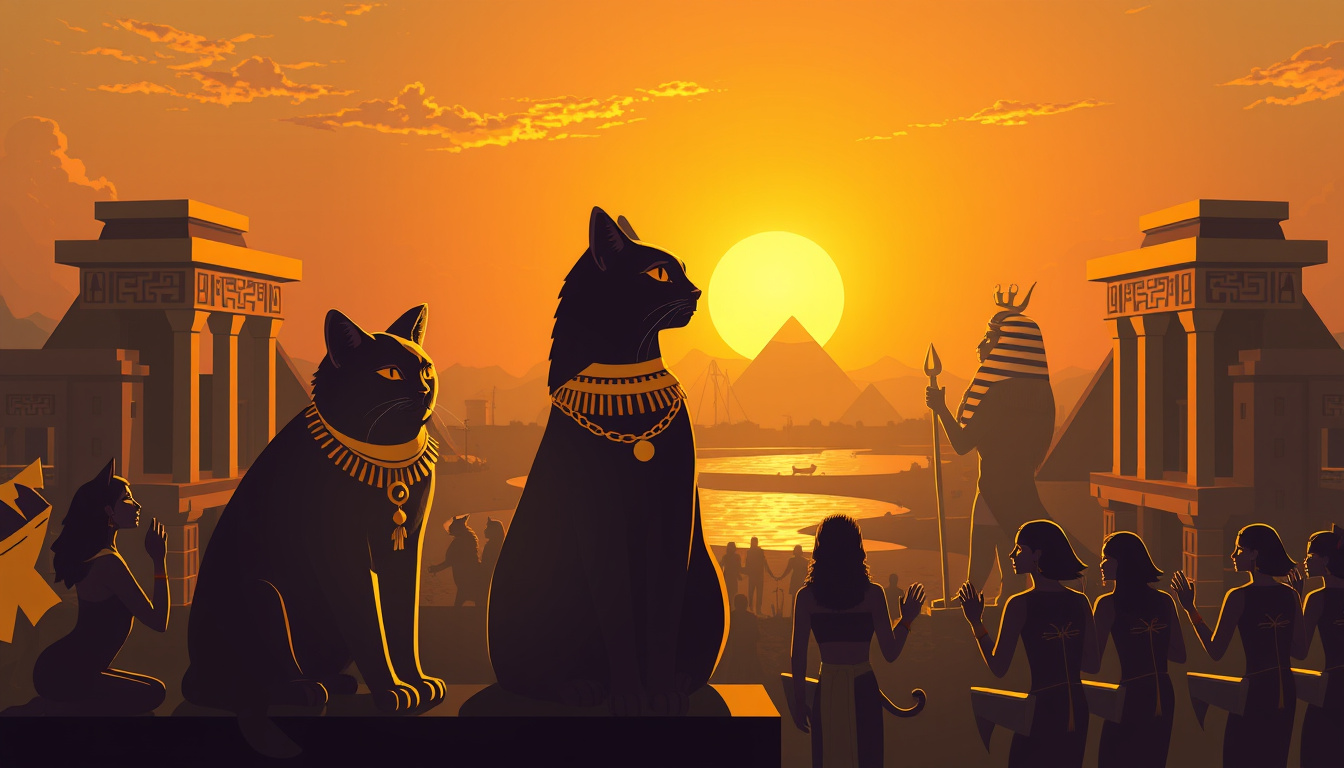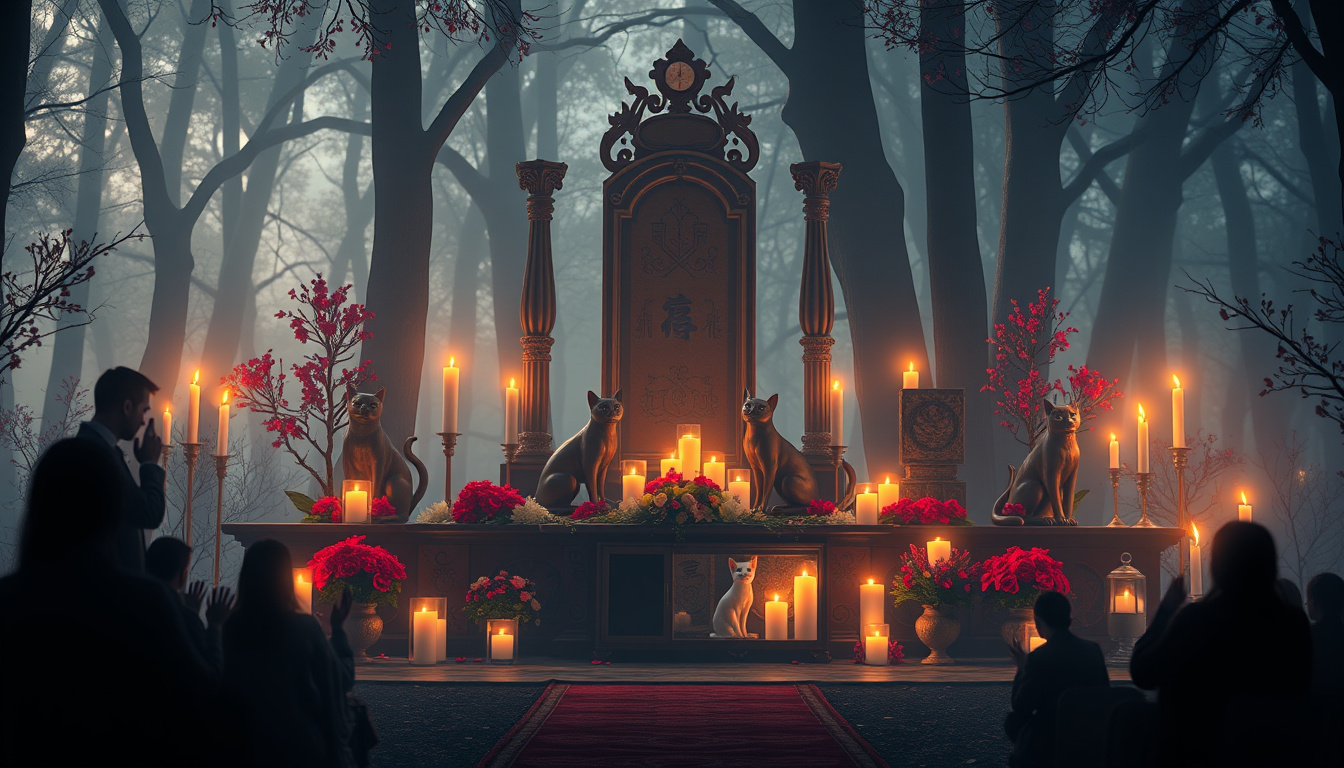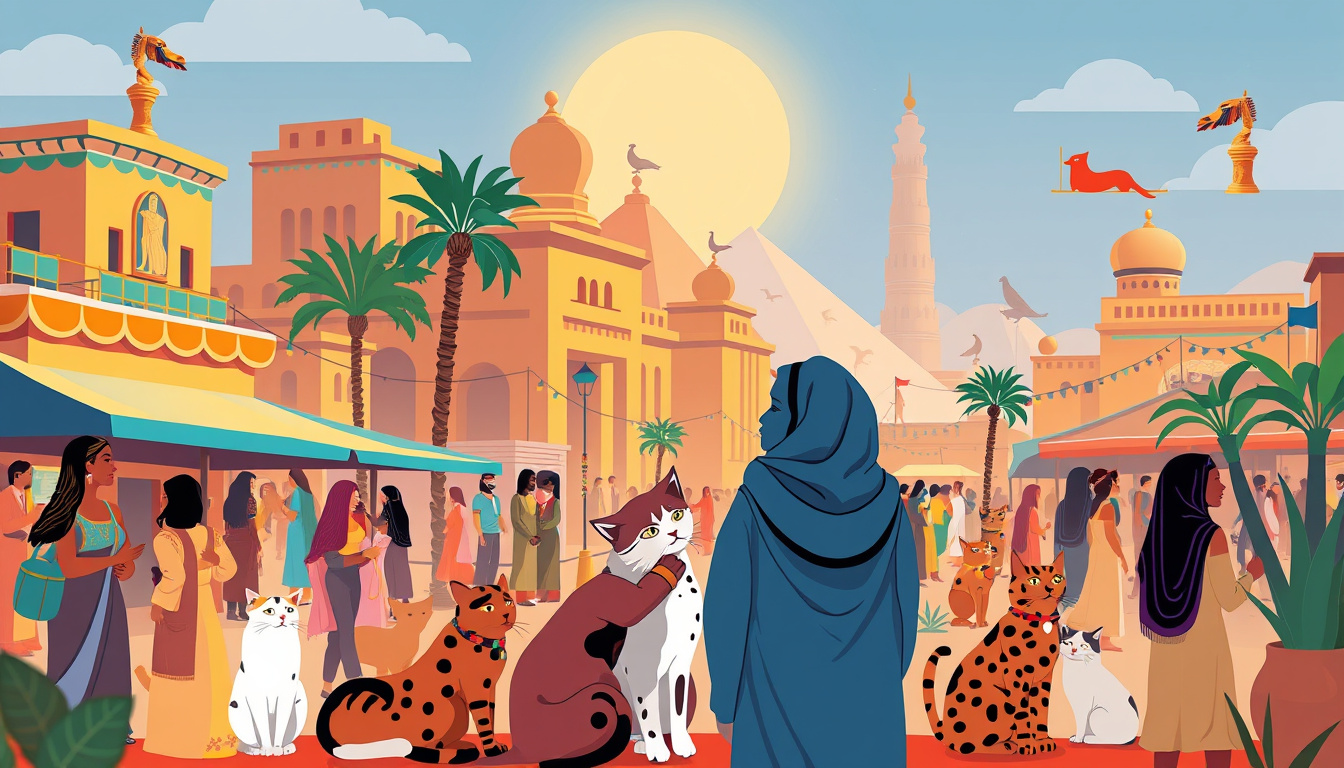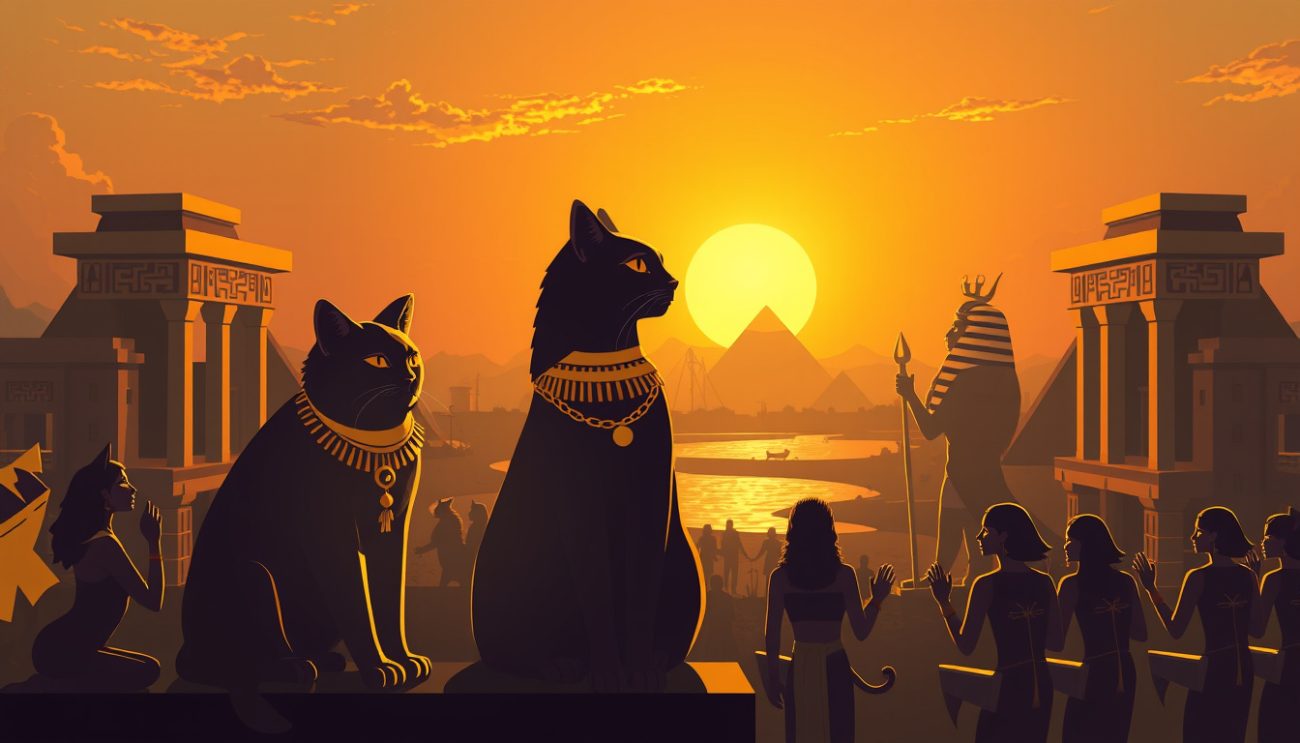Cats have always held a special place in our hearts, but nowhere is this more pronounced than in ancient Egypt, where they were revered to the level of deities. In this article, we explore the phenomenon known as ‘When Cats Were Gods: Egypt’s Feline Worship Syndrome.” We delve into the critical role that cats played in ancient Egyptian society, tracing their evolution into revered deities in mythology. We’ll examine the rituals and practices surrounding feline worship, explore the symbolism of cats in the rich tapestry of Egyptian art and writings, and finally, we’ll uncover the legacy of cat worship that surprisingly continues to influence modern Egyptian culture. Join us as we uncover the fascinating history of the sacred bond between cats and ancient Egyptians, and why these furry companions were considered divine.

Key Takeaways
- Cats held a significant place in ancient Egyptian society, revered for their hunting skills and companionship.
- Felines were considered divine beings, with deities like Bastet embodying the qualities of cats in mythology.
- Rituals surrounding cat worship included offerings and mummification, reflecting the animals’ sacred status.
- Cats were depicted in various forms of art and literature, symbolizing protection and motherhood in Egyptian culture.
- The legacy of cat worship continues today, influencing modern attitudes towards cats in Egypt and beyond.
The Role of Cats in Ancient Egyptian Society
In ancient Egyptian society, cats were more than just household pets; they were revered as sacred beings embodying divinity. This phenomenon, often encapsulated by the phrase ‘When Cats Were Gods: Egypt’s Feline Worship Syndrome,’ highlights the profound impact felines had on everyday life and spirituality in ancient Egypt. The Egyptians recognized the domestic cat’s prowess in hunting vermin, which protected their food supplies from diseases, thereby elevating their status within the community. Cats were associated with various deities, most notably Bastet, the goddess of home, fertility, and domesticity, which further fueled their veneration. Killing a cat, even accidentally, was punishable by death, showcasing the extraordinary lengths to which society went to protect these animals. Through numerous artifacts, hieroglyphs, and tomb paintings, we can see how cats were woven into the fabric of Egyptian culture, representing not just companionship but also a connection to the divine. This enduring legacy of feline worship has captivated historians and animal lovers alike, as we continue to explore the significant roles that these enigmatic creatures played in shaping ancient Egyptian life.
How Cats Became Deities in Egyptian Mythology
In ancient Egypt, the reverence for cats transcended mere companionship; it blossomed into a profound form of worship, leading to what we now refer to as the phenomenon of When Cats Were Gods: Egypt’s Feline Worship Syndrome. Cats were more than just pets; they were embodiments of divine protection, fertility, and motherhood, largely personified by the goddess Bastet. This feline deity was revered for her nurturing qualities, symbolizing home, domesticity, and fertility, while also being fierce and protective against evil spirits and diseases. The Egyptians believed that cats had mystical abilities, which is why they were often depicted in hieroglyphs and artwork, and their presence was thought to bring blessings to households. Killing a cat, even accidentally, was considered a serious crime punishable by death, illustrating the immense sanctity bestowed upon these animals during that era. As we explore how cats transitioned into esteemed figures within Egyptian mythology, it becomes evident that their reverence played a pivotal role not only in religious practices but also in the daily lives of the ancient Egyptians, leading to a unique cultural phenomenon that still captivates us today.
‘In ancient Egypt, cats were revered as gods; they were believed to embody the divine, protecting the home and offering comfort in mortal life.’

Rituals and Practices of Feline Worship
The ancient Egyptians had a profound reverence for cats, leading to the phenomenon known as ‘When Cats Were Gods: Egypt’s Feline Worship Syndrome.’ This cultural practice stemmed from the belief that cats embodied divine qualities. In Egyptian society, felines were often associated with the goddess Bastet, who represented home, fertility, and domesticity but also had a fierce side as a lioness warrior. Households kept cats not only as pets but as protectors against pests that threatened grain stores, solidifying their sacred status. Rituals surrounding feline worship involved elaborate ceremonies and offerings, with families often mourning the loss of a cat as they would a family member. Statues and amulets depicting cats were commonplace, symbolizing their revered status in both life and death. This deep-rooted respect for cats contributed to their preservation and protection, making feline worship an essential part of Egyptian culture.
The Symbolism of Cats in Egyptian Art and Writings
The allure of cats in ancient Egyptian culture cannot be overstated, particularly when considering the phenomenon dubbed When Cats Were Gods: Egypt’s Feline Worship Syndrome. This fascinating aspect of Egyptian art and writings reveals how deeply ingrained cats were in the religious and social fabric of ancient society. Represented in myriad forms—ranging from majestic bronze statues to intricate tomb paintings—cats symbolized not only protection but also fertility and domesticity. The goddess Bastet, often depicted as a lioness or a woman with a lion’s head, exemplified this reverence; she was venerated as the protector of home and family, as well as the goddess of joy and motherhood. Texts from this era often describe how the Egyptians believed that cats possessed an otherworldly essence, and harming one could invoke severe retribution. This reverence is reflected in the artworks that celebrate feline grace and strength, underscoring a culture where these enigmatic creatures were seen as divinities destined to be revered, even mummified, following death. Understanding the depth of When Cats Were Gods: Egypt’s Feline Worship Syndrome offers invaluable insight into the cultural esteem for these animals and their enduring legacy in human history.

The Legacy of Cat Worship in Modern Egypt
The legacy of cat worship in modern Egypt can be traced back to ancient practices where cats were revered and even deified. Known as ‘When Cats Were Gods: Egypt’s Feline Worship Syndrome,’ this phenomenon still echoes in contemporary Egyptian culture, where cats are often treated with great affection and care. In ancient times, cats embodied the essence of grace and mystery, believed to be the guardians of the home and the protectors against evil spirits. The goddess Bastet, depicted with the head of a lioness or domestic cat, signifies the deep-seated connection Egyptians had with these animals, which persists today. In bustling Cairo, it’s not uncommon to see felines lounging in cafes and streets, symbolizing a living heritage. The modern-day admiration for cats can be directly linked to this historical reverence, showcasing how ancient beliefs have shaped current attitudes towards these beloved companions. Understanding this relationship not only enriches our knowledge of Egyptian heritage but also highlights the ongoing significance of cats in everyday life, reflecting their lasting impact as symbols of protection, fertility, and domesticity.
Frequently Asked Questions
Why were cats so important in ancient Egyptian society?
Cats played a crucial role in ancient Egypt primarily for their ability to control pests and protect food supplies. They were also seen as symbols of grace and protection, associated with the goddess Bastet, which further elevated their status in society.
How did cats become deities in Egyptian mythology?
Cats were incorporated into Egyptian mythology due to their revered qualities and protective instincts. The goddess Bastet, depicted as a lioness or as a woman with a cat’s head, embodied fertility, femininity, and domesticity, leading to the worship of cats as divine beings.
What rituals and practices surrounded feline worship in ancient Egypt?
Rituals included offerings of food and gifts to cats, which were often treated like royalty. There were also specific burial practices for cats, as many were mummified and placed in tombs, reflecting their significant spiritual role.
What symbolism do cats have in Egyptian art and writings?
Cats are often depicted in Egyptian art as protectors of the home and symbols of fertility and motherhood. In writings, they represent grace, independence, and the connection to the divine, often linked to the goddess Bastet.
Is there a legacy of cat worship in modern Egypt?
Yes, the legacy of cat worship continues in modern Egypt, where cats are generally treated with respect and affection. Many households keep cats as pets, reflecting the deep-rooted appreciation for their role in ancient society.
